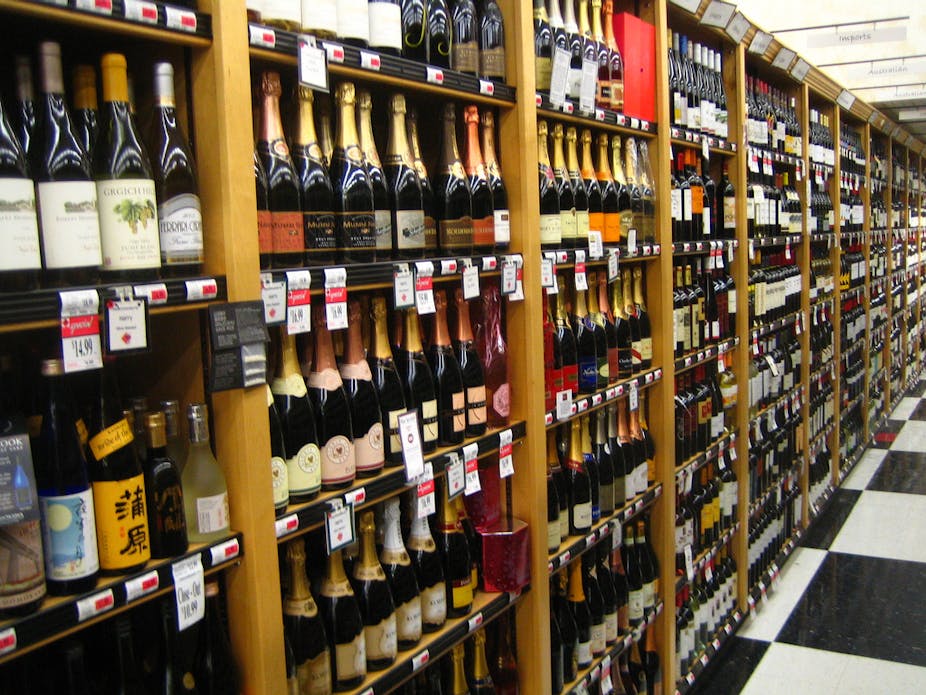In recent days, Woolworths and Coles have put out a flurry of media releases, each staking a claim to being the cheapest place to buy alcohol this summer. Coles have “declared war” on liquor prices and the Woolworths-owned Dan Murphy’s chain has fired back a response.
For the consumer, this all sounds like great news – an alcohol price war in the lead-up to Christmas. But for public health and safety, it’s worth thinking about the real cost of discounted drinks.
Beyond price
Recent estimates put the social cost of alcohol in Australia at around $36 billion a year. Approximately half of these costs come from harms experienced by people other than the drinker.

Alcohol contributes to a vast array of problems including cancer and liver disease, assaults, car accidents and other injuries, family dysfunction, neighbourhood disturbance and fear.
Recent work undertaken in Victoria demonstrates that problems from alcohol are increasing rapidly. Ambulance attendances, hospital admissions and assault rates have all increased by more than 50% in the last decade. And, crucially, a key driver of rates of alcohol problems is price.
Studies from around the world have shown that rates of alcohol harms are affected by the cost of alcohol. Heavy drinkers and young people are particularly responsive to price changes. A recent meta-analysis highlighted the links between price and a wide range of harms, including hospitalisations and deaths, traffic accidents, violence and other crime and risky sexual behaviour.
It seems that there’s no such thing as a cheap drink.
Race to the bottom
In spite of this evidence, Woolworths and Coles have spent the last 12 months in a race to the bottom on alcohol prices. In March, both companies were only stopped from selling beer at below-cost price by pressure from manufacturers.
In April, the companies engaged in a price-war on pre-mixed spirits, selling a variety of brands at below wholesale prices.
Now, with schoolies week, the Christmas party season and New Year coming up (a peak time for alcohol-related harm), we see both Coles and Woolworths-owned retailers advertising cut-price alcohol. This includes some popular wines being sold for less than $1 per standard drink.
Known harms
Retailers are well aware of the problems associated with cheap alcohol.
Coles won’t offer these discounts in the Northern Territory or the north-west region of Western Australia: there are considerable problems with alcohol in these areas and this is a promising acknowledgement by the company that cheap alcohol will not help reduce them.
But alcohol is not merely an Indigenous problem. The most recent national survey data estimates that one in five Australians drink at levels that put them at risk of long-term harm from alcohol. Nearly one in three regularly drink at levels that put them at risk of injury.

Of course, Woolworths and Coles are merely engaging in standard business practices. The $25-billion alcohol market in Australia is the focus of increasing competition, and these two retailers are already dominante that market.
Despite the rhetoric of responsibility and community-mindedness, the companies are focussed on maximising their profits. That’s why it’s necessary for governments to deal with the issue of alcohol price.
Regulatory options
A smarter approach to alcohol taxation has been recommended for both economic and public health reasons by recent government reviews. This measure has also been shown to be the most cost-effective intervention available to reduce alcohol-related harm in Australia.
But despite these evidence-based policy suggestions, the Federal government has taken alcohol tax reform off the table as a policy option.
Alternatively, governments could impose a minimum price per standard drink for alcohol, cutting down the harm associated with discounting practices, such as those currently being undertaken by Coles and Woolworths.

